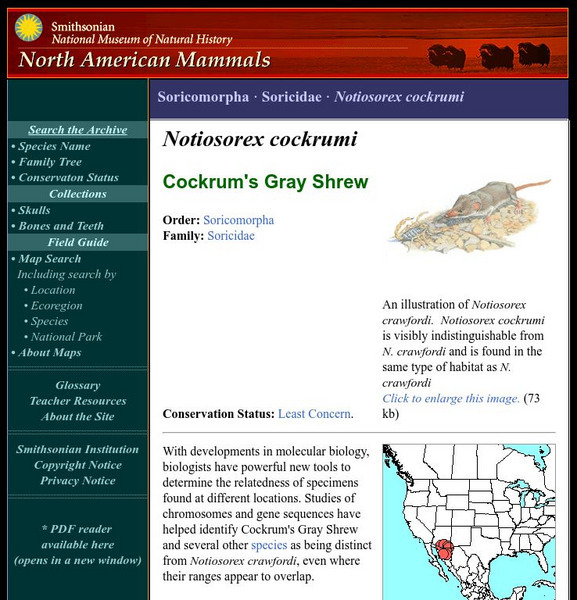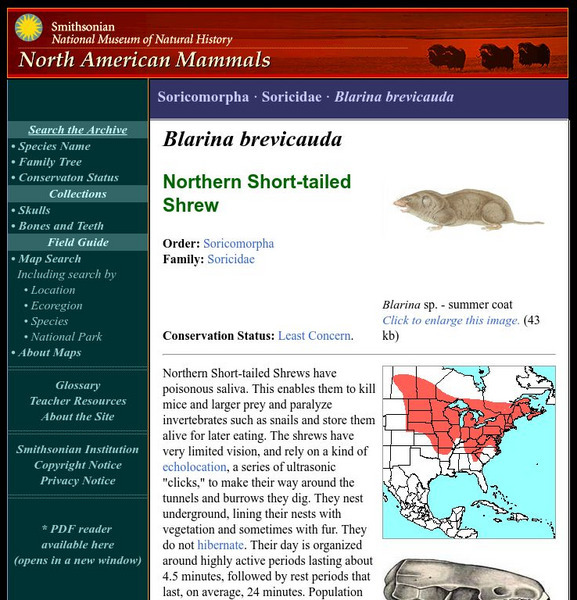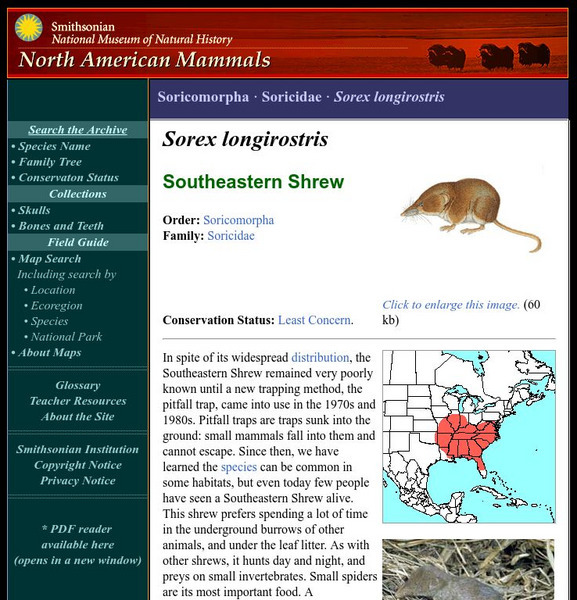Regents of the University of Michigan
Animal Diversity Web: Arctic Shrew
A detailed overview of the Arctic shrew's characteristics, physical features and how it lives. Included are photos and classification information.
Regents of the University of Michigan
Animal Diversity Web: Masked Shrew
A detailed overview of the masked shrew's characteristics, physical features and how it lives. Included are photos and classification information.
Regents of the University of Michigan
Animal Diversity Web: Pygmy Shrew
A detailed overview of the pygmy shrew's characteristics, physical features and how it lives. Included are photos and classification information.
Regents of the University of Michigan
Animal Diversity Web: Water Shrew
A detailed overview of the water shrew's characteristics, physical features and how it lives. Included are photos and classification information.
Smithsonian Institution
National Museum of Natural History: American Mammals: Baird's Shrew
Baird's Shrew has a very limited range in Oregon, in moist conifer forests. Its fur is darker brown in winter than in summer, when it is brownish-chestnut or olive-brown, with paler sides and belly. Learn more about the Sorex bairdi,...
Smithsonian Institution
National Museum of Natural History: American Mammals: Arizona Shrew
The Arizona Shrew was at first found only in Arizona, but it is now known to occur in New Mexico and northern Mexico as well. Until the 1990s, only about 22 specimens had ever been collected. Learn more about the Sorex arizonae, more...
Smithsonian Institution
National Museum of Natural History: American Mammals: Arctic Shrew
Arctic Shrews prefer grassy clearings and marshes within coniferous forests and are never very dense in population. Mortality is high early in life. Learn more about the Sorex arcticus, more commonly known as an Arctic Shrew, in this...
Smithsonian Institution
National Museum of Natural History: American Mammals: Cinereus Shrew
Mainly nocturnal and rarely seen, the Cinereus Shrew is nonetheless common and widespread below the timberline in northern deciduous and coniferous forests, in both wet and dry habitats. It is also known as the Masked Shrew and the...
Smithsonian Institution
National Museum of Natural History: American Mammals: Barren Ground Shrew
An inhabitant of the far north, the Barren Ground Shrew lives on the tundra from Point Barrow, Alaska, to the western shore of Hudson Bay, Canada. The fur on its back forms a well-defined brown stripe, and its sides and undersides are...
Smithsonian Institution
National Museum of Natural History: American Mammals: Cockrum's Gray Shrew
With developments in molecular biology, biologists have powerful new tools to determine the relatedness of specimens found at different locations. Studies of chromosomes and gene sequences have helped identify Cockrum's Gray Shrew and...
Smithsonian Institution
National Museum of Natural History: American Mammals: Northern Short Tailed Shrew
Northern Short-tailed Shrews have poisonous saliva. This enables them to kill mice and larger prey and paralyze invertebrates such as snails and store them alive for later eating. Learn more about the Blarina brevicauda, more commonly...
Smithsonian Institution
National Museum of Natural History: American Mammals: Southern Short Tailed Shrew
The Southern Short-tailed Shrew is a highly active, primarily nocturnal predator. It is most common in moist, well-drained hardwood forests or pine stands, especially where deep organic litter provides easy burrowing for shelter and...
Smithsonian Institution
National Museum of Natural History: American Mammals: Prairie Shrew
The Prairie Shrew is small, weighing only 2-5 g, brown, and relatively short-tailed. This species inhabits the northern Great Plains in Canada and the United States. Learn more about the Sorex haydeni, more commonly known as a Prairie...
Smithsonian Institution
National Museum of Natural History: American Mammals: Smoky Shrew
Shrews of many kinds often live in size-ranked communities. Such a community might include large, medium, and small shrews such as the Short-tailed, Smoky, and Cinereus Shrews, which feed, respectively, on large, medium, and small...
Smithsonian Institution
National Museum of Natural History: American Mammals: Long Tailed Shrew
The Long-tailed Shrew probably uses its long tail for balance when it is climbing among the rocks or boulders that are always present where it lives. It spends almost all its time underground, and was, until recently, thought to be...
Smithsonian Institution
National Museum of Natural History: American Mammals: American Pygmy Shrew
The American Pygmy Shrew is able to thrive in a great variety of habitats and vegetation types. It can live where the environment is wet, dry, cold, or warm. Learn more about the Sorex hoyi, more commonly known as a Pygmy Shrew, in this...
Smithsonian Institution
National Museum of Natural History: American Mammals: Marsh Shrew
Large for a shrew and with velvety dark fur, the Marsh Shrew can be found in marsh, stream, and beach habitats of the coastal rain forest in extreme southwestern Canada and the Pacific Northwest of the United States. This shrew is...
Smithsonian Institution
National Museum of Natural History: American Mammals: Southeastern Shrew
In spite of its widespread distribution, the Southeastern Shrew remained very poorly known until a new trapping method, the pitfall trap, came into use in the 1970s and 1980s. Pitfall traps are traps sunk into the ground: small mammals...
Smithsonian Institution
National Museum of Natural History: American Mammals: Water Shrew
Water Shrews are almost invariably found near streams or other bodies of water, where they find food and also escape from predators. These shrews readily dive to stream bottoms, paddling furiously to keep from bobbing to the surface,...
Smithsonian Institution
National Museum of Natural History: American Mammals: Pacific Shrew
An inhabitant of Oregon's moist streamsides, thickets, and woods, the Pacific Shrew does best in areas with brushy vegetation and fallen decaying logs. There it finds centipedes, slugs, and snails, insect larvae, amphibians, fungi, and...
Smithsonian Institution
National Museum of Natural History: American Mammals: Ornate Shrew
Since the Ornate Shrew is grayish-brown, with paler grayish underparts, and is small and inconspicuous overall, one may wonder about the inspiration for its name. Did it remind the biologist who named it, in 1895, of a well-dressed but...
Smithsonian Institution
National Museum of Natural History: American Mammals: Montane Shrew
Montane Shrews are among the most common shrews, and do well in a variety of moist habitats: thick, grassy areas near streams or rivers; meadows; thickets of willow and alder; spruce-fir forests; and alpine tundra. They are dietary...
Smithsonian Institution
National Museum of Natural History: American Mammals: Merriam's Shrew
Merriam's Shrew is noted for its predilection for dry habitats. It is most often found in sagebrush steppe, but also in grassland, brushland, and woodland, at elevations from 200 m to 2,900 m. Learn more about the Sorex merriami, more...
Smithsonian Institution
National Museum of Natural History: American Mammals: Mt. Lyell Shrew
The Mt. Lyell Shrew occurs only in the central Sierra Nevada Mountains of California and is found only at elevations above 2,000 m. Learn more about the Sorex lyelli, more commonly known as a Mt. Lyell Shrew, in this easy-to-read species...

























